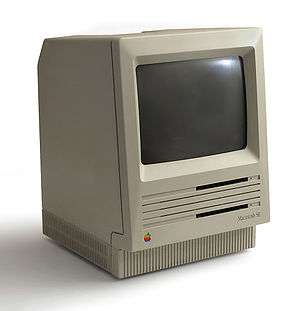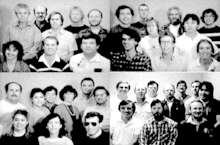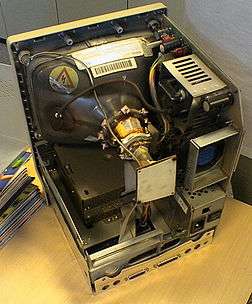Macintosh SE
 | |
| Also known as |
Macintosh SE FDHD Macintosh SE SuperDrive |
|---|---|
| Release date | March 2, 1987 |
| Introductory price |
US$2900 (dual floppy) US$3900 (with 20 MB hard drive) |
| Discontinued | October 15, 1990 |
| Operating system | 3.3-3.4, 4.0–6.0.2, 6.0.3–6.0.8, 7.0-7.5.5 |
| CPU | Motorola 68000 @ 7.8 MHz |
| Memory | RAM (150 ns 30-pin SIMM) |
| Predecessor |
Macintosh 512Ke Macintosh Plus |
| Successor |
Macintosh SE/30 Macintosh Classic Macintosh Portable |
The Macintosh SE is a personal computer that was manufactured by Apple between March 1987[1][2] and October 1990. This computer marked a significant improvement on the Macintosh Plus design and was introduced by Apple at the same time as the Macintosh II. It had a similar case to the original Macintosh computer, but with slight differences in color and styling.
Features
The SE's notable new features, compared to its similar predecessor, the Macintosh Plus, were:
- First compact Macintosh with an internal drive bay for a hard disk (originally 20 MB or 40 MB) or a second floppy drive.
- First compact Macintosh that featured an expansion slot (SE stood for "System Expansion").[1]
- Used the Apple Desktop Bus (ADB), introduced with the Apple IIGS, for keyboard and mouse interface.
- Improved SCSI support with faster data throughput.
- Better reliability and longer life expectancy due to the addition of a cooling fan.
The SE was designed to accommodate either one or two floppy drives, or a floppy drive and a hard drive. After-market brackets were designed to allow the SE to accommodate two floppy drives as well as a hard drive, however it was not a configuration supported by Apple. In addition an external floppy disk drive could also be connected, making the SE the only other Macintosh besides the Macintosh Portable and Macintosh II which could support three floppy drives, though its increased storage, RAM capacity and optional internal hard drive rendered the external drives less of a necessity than for its predecessors. After Apple introduced the Macintosh SE/30 in January 1989, a logic board upgrade was sold by Apple dealers as a high-cost upgrade for the SE, consisting of a new SE/30 motherboard, case front and internal chassis to accommodate the upgrade components.
Single-floppy SE models also featured a drive access light in the spot where the second floppy drive would be.
Additionally the SE had a special PDS slot that allowed for expansion cards, such as accelerators, to be installed. The SE can be upgraded to 50 MHz and more than 5 MB with the MicroMac accelerators. In the past other accelerators were also available such as the Sonnet Allegro. Since installing a card required opening the computer's case and exposing the user to high voltages from the internal CRT, Apple recommended only authorized Apple dealers to install cards and sealed the case with then-uncommon Torx screws.

The Macintosh SE ROM size increased from 64 KB in the original Mac to 256 KB, which allowed the development team to include an Easter Egg hidden in the ROMs. By jumping to address 0x41D89A or reading from the ROM chips it is possible to display the four images of the engineering team.[3][4]
The SE and Macintosh II were the first Apple computers since the Apple I to be sold without a keyboard. Instead the customer was offered the choice of the new ADB Apple Keyboard or the Apple Extended Keyboard.
Apple produced ten SEs with transparent cases as prototypes for promotional shots and employees. They are extremely rare and command a premium price for collectors.[5]
Macintosh SE FDHD
Originally the SE could use only Single Sided Double Density (SSDD) (400 KB) and Double Sided Double Density (DSDD) (800 KB) formatted floppy disks. In August 1989, Apple introduced the Macintosh SE FDHD with the new SuperDrive, a floppy disk drive that could handle 1.4 MB High Density (HD) floppy disks.[6] Originally marketed as FDHD (Floppy Disk High Density"), later some Macintosh SE FDHDs were labeled Macintosh SE Superdrive, to conform to Apple's marketing change with respect to their new drive. HD floppies would become the de facto standard on both the Macintosh and PC computers from then on. An upgrade kit was sold for the original Macintosh SE which included new ROM chips and a new disk controller chip, to replace the originals.
The SE FDHD was discontinued in October 1990, with the introduction of the Macintosh Classic to succeed it.


Specifications
- Processor: Motorola 68000, 8 MHz
- System Bus Speed: 8 MHz
- ROM Size: 256 kB
- Data Path: 16-bit Level 1
- RAM Type: 150 ns 30-pin SIMM
- VRAM Type: Built-in
- Standard RAM: 1 MB
- Maximum RAM: 4 MB
- RAM Slots: 4 (in pairs)
- Standard Hard Drive: 20 MB
- Int. Hard Drive Type: SCSI
- Standard Disk: 3.5 in, 800 kB, 800 kB x 2 (auto)
- Exp. Slots: SE PDS
- Battery Type: 3.6 V lithium
- Display: 512x342 9 inches (23 cm) monochrome[2][6]
- Video memory: 512x384x1
- Supported Mac OS: 3.3–7.5.1, 7.5.3–7.5.5
- Avg. Weight: 17.0 lb/7.7 kg
Emulators
- Mini vMac SE & SE FDHD
Timeline of compact Macintosh models

See also
References
- 1 2 Joel West (1987-03-02). "Macintosh II and Macintosh SE announced". Newsgroup: comp.sys.mac. Usenet: [email protected]. Retrieved 2014-01-26.
- 1 2 "Archived - Macintosh SE: Technical Specifications". Apple Knowledge Base. 2012-04-19. Retrieved 2014-01-26.
- ↑ "Macintosh Plus Easter Egg - Image of Designers in ROM". 1999-09-12. Retrieved 2014-01-26.
- ↑ Trammell Hudson (2012-08-21). "Ghosts in the ROM". NYC Resistor. Retrieved 2014-01-26.
- ↑ "Transparent Macintosh SE". Low End Mac. Retrieved February 8, 2007.
- 1 2 "Archived - Macintosh SE FDHD: Technical Specifications". Apple Knowledge Base. 2012-04-19. Retrieved 2014-01-26.
External links
- 1987 Apple Computer, Inc. promotional video "Own-a-Mac - The Movie"
- The Mac SE Support Pages Repair & upgrade advice.